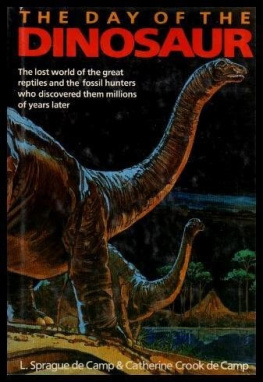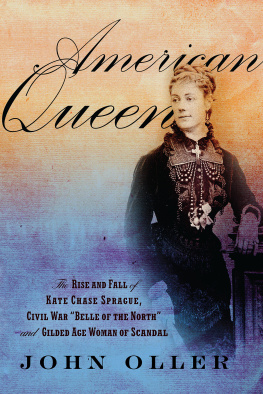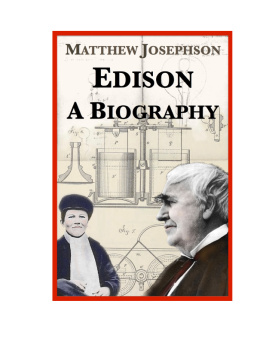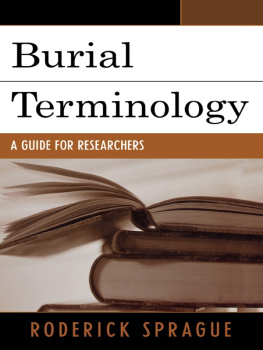Frank Julian Sprague

Frank Julian Sprague (18571934) photographed circa mid-1890s. Middleton Collection.
Frank Julian Sprague
ELECTRICAL INVENTOR & ENGINEER
WILLIAM D. MIDDLETON & WILLIAM D. MIDDLETON III
Foreword by JOHN L. SPRAGUE

This book is a publication of
Indiana University Press
Office of Scholarly Publishing
Herman B Wells Library 350
1320 East 10th Street
Bloomington, Indiana 47405 USA
www.iupress.indiana.edu
2009 by William D. Middleton and William D. Middleton III
All rights reserved
No part of this book may be reproduced or utilized in any form or by any means, electronic or mechanical, including photocopying and recording, or by any information storage and retrieval system, without permission in writing from the publisher. The Association of American University Presses Resolution on Permissions constitutes the only exception to this prohibition.
This book is printed on acid-free paper.
Manufactured in the United States of America
Library of Congress Cataloging-in-Publication Data
Middleton, William D., date
Frank Julian Sprague : electrical inventor and engineer / William D. Middleton and William D. Middleton III ; foreword by John L. Sprague.
p. cm. (Railroads past and present)
Includes bibliographical references and index.
ISBN 978-0-253-35383-2 (cloth : alk. paper)
1. Sprague, Frank J. (Frank Julian), 18571934. 2. InventorsUnited StatesBiography. 3. Electrical engineersUnited StatesBiography. 4. Electric railroadsUnited StatesHistory20th century. I. Middleton, William D., date II. Title.
TA140.S7M53 2009
621.3092dc22
[B]
2009017091
2 3 4 5 19 18 17 16 15
To Professor George M. Smerk, our long-time friend and colleague, whose career in education and transportation have deeply enriched the fields at many levels. His assistance on this and many other projects is much appreciated.

Photo courtesy of Mary Ann Smerk.
RAILROADS PAST & PRESENT
George M. Smerk, editor
A list of books in the series appears at the end of this volume.
CONTENTS
by John L. Sprague
FOREWORD
A 1932 photograph shows a trim elderly man holding a chubby two-year-old child. The man is well dressed and has a slightly quizzical expression as he regards his armful. His face is narrow and seems constructed of sharp angles and lines. He has a full head of hair, a prominent nose, and a full but well-trimmed mustache. But it is his eyes that grip you. Even in the slightly faded image, behind his metal-rimmed glasses they seem to glitter with intelligence. On the other hand, the child is clearly oblivious to the fact that the arms holding him belong to the man who, at the time, was renowned as the Father of Electric Traction. This photograph is the only recorded proof I have that my grandfather and I ever met. He died only two years later and unfortunately I have no recollection of either the event or of him.
This is not true of my grandmother, his second wife, Harriet, who outlived her husband by some 35 years. I met and talked with her often as I was growing up in Williamstown, Massachusetts, and she was a warm and loving companion. However, this sweet little old lady was full of surprises. She was a renowned Walt Whitman collector, and also showed a steely ferocity when defending the legacy of her beloved Frank. Her 1947 24-page monograph, Frank J. Sprague and the Edison Myth, was, I believe, the first serious attack on the legacy of the Wizard of Menlo Park. In the book that follows, the Middletons spend a full chapter on the initially cordial and then increasingly contentious relationship between these two men.
As I grew up in Williamstown, Frank Sprague was all around me. There were portraits and photographs and memorabilia of all kinds. One of the favorites that I still have is a plastic molded length of approximately one-inch cable that was part of the first three-wire underground distribution system in the world, and which was installed in Brockton, Massachusetts, in October 1883 by Thomas A. Edison with Frank J. Sprague as the Resident Engineer in Charge of Construction. Another was a large-scale model of one of his early street railway wheelbarrow motor suspension trucks that resided in my fathers office throughout his business career. All of our family members were, and still are, in awe of this famous inventor. Yet as I grew up we almost never talked about him. Recently discovered family letters indicate that, while he was a loving father, Frank Sprague was often too busy or away to spend much time with his children. At the time I also sensed that my father was much closer to his mother and that his feelings about his father were ambivalent. He certainly had a fierce pride in Frank Spragues obvious genius as an inventor and entrepreneur. Yet he also seemed frustrated by the fact that, when Frank Sprague died in 1934, the modest fortune that he had built over the years, primarily as the result of selling The Sprague Electric Company to General Electric in 1902, had vanished. As far as I know, my father completely supported his mother during the last 35 years of her life. She died in 1969 at the age of 93.
In the late 1950s, Harriet, my father, and his younger brother, Julian, contracted with science writer E. S. Lincoln to write a biography of Frank J. Sprague. Completed in late 1959, it was circulated to more than a dozen different publishers. While reception was lukewarm, it reached all the way to galley proofs with The Bobbs-Merrill Company before discussions fell apart over the publishers demand for major underwriting by the family. Unhappy with the depiction of Frank Spragues personal life in the Lincoln biography, they then turned to Frank Rowsome, Jr., for a rewrite. At the time, Rowsome was managing editor of Popular Science and had written Trolley Car Treasury, a picture book published in 1956. Unfortunately, after circulation to a number of different publishers, the much more readable Rowsome manuscript met the same fate when negotiations with McGraw-Hill collapsed after the publisher made similar underwriting demands. Ironically, although I joined the Research Labs of the second Sprague Electric Company (founded in 1925 by my father as The Sprague Specialties Company) during this same period, I only learned of the existence of these two manuscripts in 1991 while reviewing my fathers papers after his death.
In the early 1980s a series of fortunate events occurred that created a renewed and growing interest in my grandfather. First, I found a copy of Harold Almost simultaneously I received a copy of a 1984 French article concerning La Fin des Sprague, the retirement of the Paris metro line Le Sprague. Having run since 1903, the line was an amalgamation of the Sprague and Thomson railway systems. Even until quite recently, some of its cars were run on holidays, used in nighttime maintenance runs, and were part of an exclusive all-night tour under Paris sponsored by ADEMAS, the Association dExploitation du Matriel Sprague. After several trips to France and correspondence with a whole group of new friends both in France and in the United Kingdom, I now recognize that in both of those countries Frank J. Sprague is better known than he is in the United States. I did find an important exception to this observation when, on September 30, 2006, I participated in the celebration A Century of Third Rail Power in New York Citys Grand Central Station. The third rail electrification system was co-invented by William J. Wilgus and Frank J. Sprague and there I met yet another group of people who know of and revere my grandfather.
Next page











